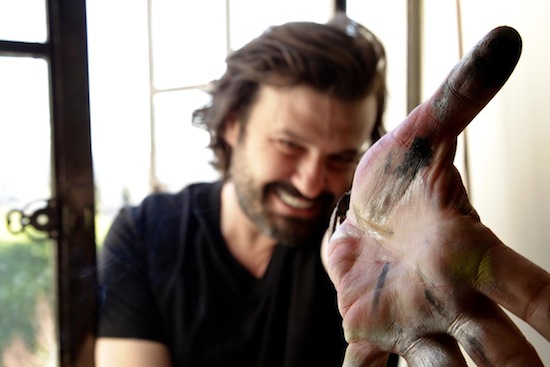I’ve never flown Business Class before. From this seat prior to take off I can see the pilot in the cockpit with my own eyes, and if I lean forward far enough I might be able to fly the plane myself. Ten minutes ago I’d been queueing before realising my priority booking meant I could push through disgruntled and inanimate bodies to board ahead of almost everyone. I feel like a scab squeezing past my proletariat comrades.
When I arrive at seat 2c there’s a Louis Vuitton coat spread across it. I assume there’s been a mistake, that I’ve got the wrong number printed on my ticket and the Louis Vuitton is present and correct and where it should be. The hostess whips it away and puts it in the overhead compartment and I’m sat there now wondering if anyone can tell I bought my shirt from Mencap.
Ironically I’d been so poor this week that I’d been unable to attend a friend’s party in Brittany. Then a call came out of nowhere and suddenly I’m spending my Saturday morning bobbing along a Venetian waterway like Judith Chalmers tanning the leather at high speed. I’m visiting the 55th Venice Biennale to interview Spanish painter Domingo Zapata. Domingo had apparently asked people in his circle about writers and somehow my name had come up. He puts his hand in his pocket and plucks me from home, just like that.
In person Domingo is every inch the passionate Spanish painter you felt Woody Allen overdid in Vicky Cristina Barcelona, from the bristles on his chin to the flecks of paint all over his white t-shirt and under his nails. You suspect its not a cultivated look and imagine he’s dressed the same way since he was a 12-year-old mixing paints for his father. A dreamy, faraway stare you can’t fake, and neither can you fake technique.
“In order to understand contemporary art you need to study the history of art, you need to know about Neoclassicism, French Impressionism, Romanticism; you need to know that in order to understand it,” he’ll tell me later. “You draw inspiration from your day to day life but also your research and study from the masters.”
Domingo is a rock & roll painter – I know this because I ask him during the interview if he’s rock & roll and he says he is. His friends certainly think so. He hangs out with Marilyn Manson and Serj Tankian and Keith Richards’ daughter Alexandra, and he sells his paintings to everyone from Johnny Depp to Damien Hirst. Depp is a dedicated collector of Zapata’s works, as is Leonardo DiCaprio and George Soros and some European royalty as well. Domingo has been linked romantically with Scarlett Johansson and Pamela Anderson. He’s a tabloid writer’s wet dream. Researching and trying to find the truth about Domingo Zapata among all the column inches of nonsense written about him is like trying to find intelligent life at a Beady Eye concert.
Success breeds contempt, especially in the art world, and if the redtops can’t get enough of his celebrity then some broadsheets are less willing to see beyond the friendships with the Lindsay Lohans of this world. A recent New York Times article ran with the snide headline: ‘Domingo Zapata’s Best Known Work May Be Himself’. The author of the piece claimed Hollywood stars are willing to pay upwards of $150,000 just to hang out with him, the implication being that the acquisition of one of his paintings is secondary.
Zapata paints mainly from his studio atop the Bowery Hotel in Manhattan, which may go some way to explaining why the organ is so interested in him. He also has a studio in Los Angeles and one in the 16th Arrondissement in Paris, and just recently he’s been spending up to 14 hours a day painting at Palazzo da Mula, the 15th Century gothic villa housing his first solo exhibition at the Biennale entitled A Midsummer Night’s Dream. Domingo arrives about a half hour after I’ve had an exclusive viewing and decides we must eat. He tells me over lunch that he’s been relishing the experience of painting in Venice for the last couple of months, mainly because of the lack of distractions, and he’ll continue to paint here for two months more adding further works to the exposition. Venice itself is an inspiration, he says, a museum without walls.
I’ve flown in from Paris which has its fair share of beautiful baroque souffles plonked on Val d’Oise limestone, but nothing can quite prepare you for the fantasy la la land that is Venice if you’ve never visited before. It’s hard to believe anyone actually lives here amongst the leaning buildings and the Istrian marble and the Basilica, except for maybe goblins and fairies and mythical princesses. One can see how it might fire up the imagination of an artist, and how Zapata may have decided on the titular Shakespearean theme. Maybe the amphibian Kevin Costner from Waterworld would get on well here, but having nearly slipped into the canal on some invisible algae while trying to photograph a gondola, I decide it’s definitely not a safe place to actually live for a person without gills. There should be fences and health and safety notices warning you not to tread by the water’s edge and placards warning you not to follow dwarves in red raincoats.
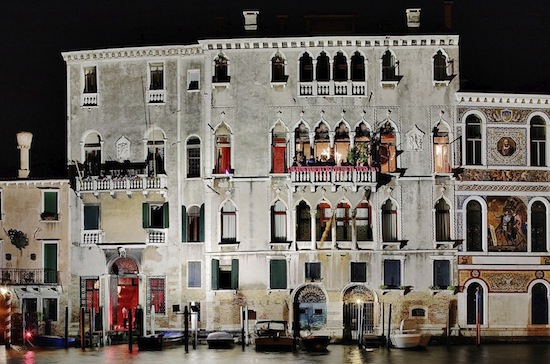
“Nothing happens here”, says Domingo, laughing as he regards the menu at a surprisingly modest little eatery he’s taken me to for dinner. That’s not strictly true; last night he went out on the town for drinks with friends and ended up at a pop-up Bungalow 8. There will be plenty of distractions over the coming weeks to serve the decadent collective impulses of the art glitterati. We’ve not started the interview officially yet, but Domingo surprises me by bemoaning the art scene’s party element. “They’re not here for the art,” he complains as he scours the menu, though he soon shrugs it off.
“The mussels are to die for,” he says, kissing his fingers and making that slightly pained expression people do that implies pleasure. I’m a vegetarian and I might want some spinach I tell him. Domingo says he’ll take care of it, and he does just that, calling the waiter over and ordering for both of us and assuring me I won’t be disappointed. I’m not disappointed it transpires, both courses are excellent. He is clearly a man who operates with supreme self confidence, who puts the epic into epicurean, a bon vivant who lives to indulge, whether that be food or drink or sex, or at least that’s what I’ve been led to believe reading his press. How much is true I wonder?
“About one percent”, he estimates. “I’ve never met Angelina Jolie in my life, for instance, but when I do she’s going to punch me in the face!”
He doesn’t expound on what’s been written but then he doesn’t have to. We live in an age where a magazine will close in on Cameron Diaz’s face and circle a pimple in red ink and put it on the cover, or where photographers will follow Johnny Depp and his family wherever they go and take endless snaps with a zoom lens. Depp himself queried why anyone would need another picture of him given that there are millions out there already.
“That poor fucking guy,” says Domingo, striking up a Marlboro Light. “Everyone’s got a camera now! We’re all paparazzi now.”
As we wander back to the Palazzo da Mula, Domingo ponders on who the great artists of the day are and concludes we’ll not know for a couple of hundred years, when most of us will be dead. Interestingly he calls himself an ‘artist du jour’ on his website, or at least the makers of his website have made that claim. The truly great artists working now are not interested in self promotion, he states, all they want to do is create. I’m unsure if this represents a lapse in self-awareness or if he’s engaging in double bluff. One thing I will say is that he has acquitted himself well so far, but then maybe that’s because he just bought me dinner.
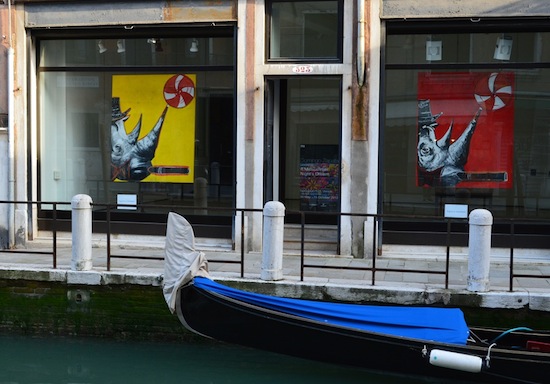
“The lunatic, the poet, and the lover are of imagination all compact… Lovers and madmen have such seething brains, such shaping fantasies, that apprehend more than cool reason ever comprehends.”
The words above are spoken by Theseus in A Midsummer Night’s Dream and act as the inspiration for Domingo’s exhibition. It’s an impressively curated show, with iconoclastic images of Mary and Jesus hanging in the villa’s chapel, bullfighters’ uniforms doused in acrylics and splattered with paint and aerosols, and mosaics of the Mona Lisa covered in graffiti. Some paintings appear to mimic stage interpretations of the play while others are abstract. There are homages to Picasso and Matisse and Goya, and different media employed in collage form. The message might be unclear but the explosion of colour is vivacious and life-affirming in the extreme. It’s a carnival of vivid light and celebration, a bit like Domingo himself.
“The world needs paint!” he roars. “The world needs sensations that are not chemical. You need sensations that will fill your body with happiness just by looking at it!”
Domingo has spent time walking around Venice checking out the work of other artists and hasn’t always been impressed with what he’s found.
“Artists are becoming art directors. You can’t be an artist and not pick up a brush, or be a sculptor and only design the sculpture and tell someone else to do it. The craftsmen becomes the artist then.” He’s warming to his theme. “I go to the Biennale and all I see are these crazy installations and I’m like ‘What the fuck is this?! Why do I need so much negativity?’ I appreciate it, I admire it, I don’t want to criticise it,” he says, and you know he doesn’t admire it and he’s going to criticise it.
“I buy the New York Times and I see it on the front page every day, a bomb in Iraq, a bomb here, a bomb there, death and shit. I go to see art, give me some romanticism!”
But then doesn’t art just become escapism with no commentary?
“Art is about statements, yes, you can make political statements with your art, but that’s old. We have the internet, we have blogs, we have educated people that know about a lot of stuff and you don’t need a painter who’s going to reflect the anger of a political situation. With today’s technology, a video or photo will tell you a lot more and will express it better. Paintings 200 years ago were like today’s internet, but now? Come on!”
I suggest that some of those modern artists might think paint itself is old or even redundant.
“I dunno,” he says laughing. “I think the secret to my success is that I keep painting. And nobody does it!
I wonder if he considers himself an artist or a painter foremost?
“I consider myself a painter because I incorporate paint in everything I do. Even if I do a sculpture I paint on it. So I am a painter, that’s my media. I love to work with everything else, to explore, always from the perspective of a painter.”
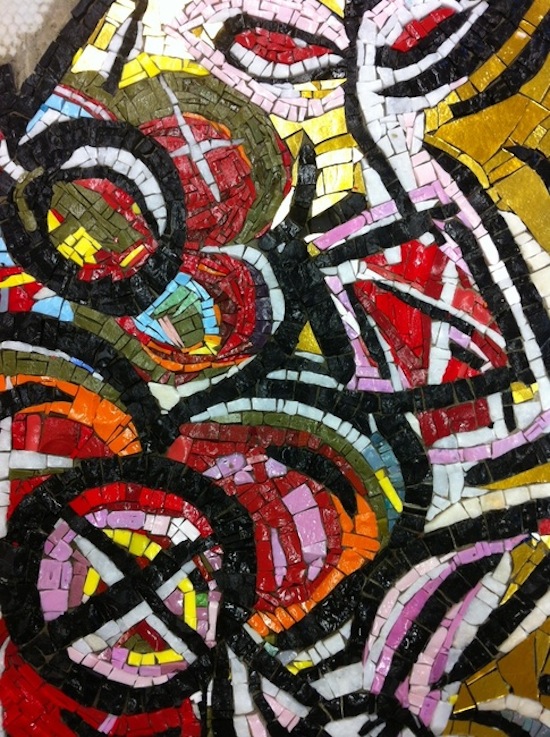
I ask Domingo about the religious images. Is he religious himself? He takes a while to ponder on this.
“A friend asked me about a year ago if I believe in God? I was born with a belief but that was the first time I’d questioned it myself. I was Catholic born, do I believe in Catholicism? Then they hired me to paint a synagogue in New Jersey… I was messed up! Then I started looking at religious paintings and Goya’s Christ and it just came to me: I don’t believe in any one religion but I believe in an energy that inspires. It was a very important time for me as a person and as an artist to start questioning that, because now I can express it.”
So you’re not a guy who’s been wracked with Catholic guilt his whole life then?
“No never. I’ve always had a free mind.”
Domingo has a way of answering questions where everything he says is delivered with profundity even if what he’s saying isn’t that profound. Interestingly he operates with a certain amount of humility when he’s just having dinner with you, but turn the tape machine on and he becomes an amplification of some sagely, mystical character drawn from his imagination. You sort of wish he’d just be himself, he’s certainly far more engaging and funny and likeable when he is. I’ve seen it written that he sounds a bit like Derek Zoolander in interviews, and I can see there’s some truth in that. When I asked him about the inspiration behind the title he says: “There is a big question for me about why things happen the way they happen and the rationality of our decisions. We fall in love: why do we fall in love? Why do you like or dislike somebody? I’ve been wondering about that for years. Why do I not like fish?”
That said he’s a great raconteur and a glorious eccentric who’s led a charmed and interesting life. Before he became a painter he was on course to become a banker on the advice of his father, and had the foresight to sell a dating site for a lot of money back in 2002 before online dating was commonplace. When he lived in Paris he would get up every morning as ritual, head to the Louvre and visit the Mona Lisa before getting on with the rest of his day (and he still does it now when he returns to France). Whilst living in Paris he got a tattoo on his left arm of a girl he sketched in a bistro, a stranger he never approached, who became the subject of his last exhibition: ‘The Love Of My Life Is In Paris’ (“Now if I get hurt or have relationship problems, I close my eyes and think, ‘I’ll find her sometime,’” he smiles. “I have faith… God again. I dunno, she might be married and weight 300 pounds now.”)
In what seems like another life again, Zapata worked in the music industry, and wrote lyrics with Jon Secada, Montserrat Caballe and a guy called Michael Jackson: “You could not consider me a musician or a songwriter,” he says bashfully, before adding with some grandiloquence, “I’m more a friend of a friend that Michael liked. He said ‘I love your energy, let’s do this together’ and that was Michael the genius.”
One of the more bizarre stories about Zapata that made it into print is that he wrote the ‘Macarena’, though there is an element of truth in it: “Let’s make this clear so I don’t have to write a press release about it. The guys that wrote ‘Macarena’ [Los del Rio] are good friends of mine. I love flamenco, its my heritage coming from the south of Spain, and they were doing a new version for the 15th anniversary and they wanted somebody to do a new version in English and Spanish. I co-wrote the new version with Jon Secada but I did it because I knew them. They were like ‘Who’s going to do this? Domingo can do it!’ So again it was something beautiful and organic.”
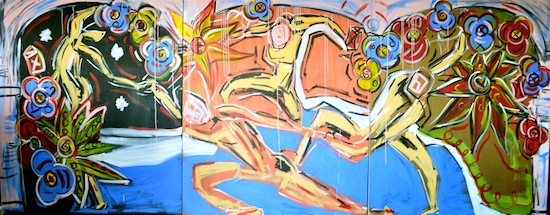
What does the polymath have left to achieve then?
“Every painter had a queen to paint, so I want a queen to paint. I want to paint the Queen of England, as beautiful and shiny as she is.”
It’s a medium where people become immortalised – something Domingo is no doubt aware of – and once you paint a Queen you’ve joined the club. He’d best get on with it though, none of us are getting any younger.
“Maybe she’ll read your article and give me a call,” he laughs.
Zapata made his first bucks selling paintings of polo horses, and I wonder if – given his chosen subjects – he has a clandestine desire to join the British aristocracy.
“A friend gave me one of those lordships that you can buy online, so I’m getting closer! I’m a Lord online, ha ha. I love the sport, I love the energy of it, the smell of it, I love it! The strength, the fight; I was attracted to it as a kid but I couldn’t afford it, so I started painting it”.
I wonder if this is indicative of an aspirational psyche from an early age?
“I guess. I started painting it and then I did get a polo pony and I play polo; I love the sport and now I can experience it on the horse. So yeah I started painting and dreaming and things can
happen. I always wanted to be a painter and daydreamed about who I am today. I do think that if you work hard and you keep dreaming things will happen for you. I would be happy painting anything now if I wasn’t famous or successful or painting on canvas; I would be painting houses or cars and I would be a very happy person. But I had a dream and I’m living my dream.”
Domingo Zapata is puckish like his work, and while some of what he says is ridiculous he’s clearly a great person to be around. He’s someone who makes you believe things can happen, who has an infectious enthusiasm and zest and vitality, and it’s no surprise Hollywood A-listers want to hang out with him, even if they don’t pay him for the privilege.
“I don’t think Johnny Depp needs to pay me $100,000 to hang out with me,” he says in response to the New York Times article. “Or George Soros. I think they have their own lives to be getting on with and they’re way cooler than me. Especially Johnny.”
His dreams have certainly come to fruition in A Midsummer Night’s Dream, and as his reputation grows so does his celebrity. Whatever he might have to say for himself, it’s clear his paintings can speak for themselves.
A Midsummer Night’s Dream is at the Palazzo da Mula in Venice until October 15 2013

